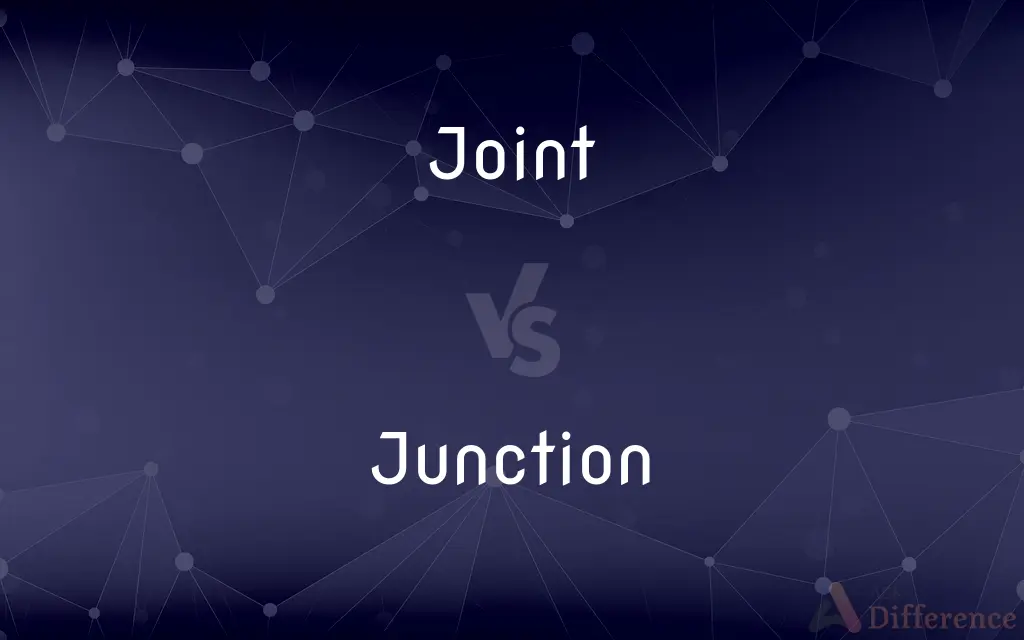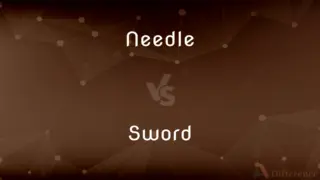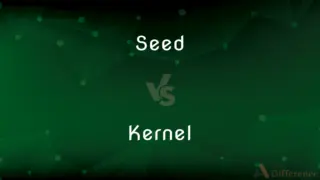Joint vs. Junction — What's the Difference?
Edited by Tayyaba Rehman — By Maham Liaqat — Updated on March 15, 2024
A joint is where two components meet and may allow movement (like in bones or construction), whereas a junction is a point of convergence or branching, often used in transportation or networks.

Difference Between Joint and Junction
Table of Contents
ADVERTISEMENT
Key Differences
A joint primarily refers to the meeting point between two or more parts, whether in anatomy (such as knees and elbows) where it allows for movement, or in construction where elements are connected. Whereas a junction is typically associated with the point where two or more paths meet, commonly used in the context of roads, railways, or networking, emphasizing the aspect of convergence or divergence rather than movement.
Joints in the human body are structured to facilitate various types of movement, including bending, rotating, and sliding, depending on the joint type (hinge, ball-and-socket, etc.). On the other hand, junctions, such as traffic junctions, focus on managing flow, directing vehicles from multiple pathways into organized directions, without implying mobility within the junction itself.
In engineering, a joint might be designed to bear loads, allow for expansion and contraction, or provide flexibility to structures like bridges or buildings. Junctions in this context, such as electrical junctions, are points where electrical connections are made, serving to route the flow of current rather than support physical movement or load bearing.
From a biological perspective, joints are critical for locomotion and manipulation, evolving in complexity to enable a wide range of physical activities. Whereas, junctions in biology, such as neuronal junctions, facilitate communication between cells or systems, highlighting their role in transmission rather than physical movement.
While both joints and junctions are points of connection, their purposes diverge significantly: joints often relate to physical mechanics and movement, facilitating interaction between moving parts, whereas junctions are about guiding, distributing, or transmitting within networks or systems, be they physical, biological, or technological.
ADVERTISEMENT
Comparison Chart
Definition
A point of connection between two parts, allowing movement or rigidity.
A point where things converge or diverge, often used in transportation or networks.
Primary Function
Facilitates movement or support in constructions and organisms.
Manages flow, routes, or connections in systems or pathways.
Contexts
Anatomy, construction, mechanics.
Roads, railways, electrical or data networks.
Examples
Knee joint, woodworking joints.
Railroad junction, internet junction.
Types
Hinge, ball-and-socket, fixed, pivot.
T-junction, Y-junction, network junction, synaptic junction.
Compare with Definitions
Joint
A structure in the human or animal body where two parts of the skeleton are fitted together.
The knee joint allows for bending and straightening of the leg.
Junction
A place where two or more roads meet.
The accident happened at the junction of Fifth and Main.
Joint
A place where two things or parts are joined.
The pipeline was inspected for leaks at every joint.
Junction
A critical point in a network where connections are made.
The data center houses a major internet junction.
Joint
A business or establishment.
We're going to that new burger joint downtown tonight.
Junction
In biology.a connection between neurons or between cells.
The synaptic junction is crucial for transmitting signals in the nervous system.
Joint
A point of connection between pieces of wood or other materials.
The carpenter crafted a dovetail joint to securely assemble the drawer.
Junction
A point where two or more things are joined.
The electrician checked the wiring at the junction box.
Joint
In geology, a fracture in rocks where there has been no movement.
Rock climbers often look for joints in the rock face to use as handholds.
Junction
The act of joining or the state of being connected.
The junction of these two rivers creates a powerful current.
Joint
A joint or articulation (or articular surface) is the connection made between bones in the body which link the skeletal system into a functional whole. They are constructed to allow for different degrees and types of movement.
Junction
The act or process of joining or the condition of being joined.
Joint
A place or part at which two or more things are joined.
Junction
A place where two things join or meet, especially a place where two roads or railway routes come together and one terminates.
Joint
A way in which two or more things are joined
A mortise-and-tenon joint.
Junction
A connection between conductors or sections of a transmission line.
Joint
A point of articulation between two or more bones, especially such a connection that allows motion.
Junction
The interface between two different semiconductor regions in a semiconductor device.
Joint
A point in the exoskeleton of an invertebrate at which movable parts join, as along the leg of an arthropod.
Junction
A mechanical or alloyed contact between different metals or other materials, as in a thermocouple.
Joint
(Botany) An articulation on a fruit or stem, such as the node of a grass stem.
Junction
The act of joining, or the state of being joined.
Joint
(Geology) A fracture or crack in a rock mass along which no appreciable movement has occurred.
Junction
A place where two things meet, especially where two roads meet.
Joint
A large cut of meat for roasting.
Junction
The boundary between two physically different materials, especially between conductors, semiconductors, or metals.
Joint
A cheap or disreputable gathering place
"The tavern is ... just a joint with Formica tables, a vinyl floor, lights over the mirrors" (Scott Turow).
Junction
(nautical) The place where a distributary departs from the main stream.
Joint
A building or dwelling.
Junction
(rail transport) A place where two or more railways or railroads meet.
Joint
A prison. Often used with the.
Junction
A point in time between two unrelated consecutive broadcasts.
Joint
(Slang) A marijuana cigarette.
Junction
A kind of symbolic link to a directory.
Joint
Shared by or common to two or more
Our joint presence.
A joint income-tax return.
Junction
(programming) In the Raku programming language, a construct representing a composite of several values connected by an operator.
Joint
Sharing with another or others
A joint tenant.
Junction
(electronics) electrical junction: a point or area where multiple conductors or semiconductors make physical contact.
Joint
Formed or characterized by cooperation or united action
Joint military maneuvers.
Junction
(of roads or tracks) To form a junction.
Joint
Involving both houses of a legislature
A joint session of Congress.
Junction
The act of joining, or the state of being joined; union; combination; coalition; as, the junction of two armies or detachments; the junction of paths.
Joint
(Law) Regarded as one, especially with regard to tort liability or interest in property.
Junction
The place or point of union, meeting, or junction; specifically, the place where two or more lines of railway meet or cross.
Joint
(Mathematics) Involving two or more variables.
Junction
The place where two or more things come together
Joint
To combine or attach with a joint or joints
Securely jointed the sides of the drawer.
Junction
The state of being joined together
Joint
To provide or construct with joints
Joint a boom on a crane.
Junction
The shape or manner in which things come together and a connection is made
Joint
To separate (meat) at the joints.
Junction
Something that joins or connects
Joint
Done by two or more people or organisations working together.
The play was a joint production between the two companies.
Junction
An act of joining or adjoining things
Joint
The point where two components of a structure join, but are still able to rotate.
This rod is free to swing at the joint with the platform.
Joint
The point where two components of a structure join rigidly.
The water is leaking out of the joint between the two pipes.
Joint
(anatomy) Any part of the body where two bones join, in most cases allowing that part of the body to be bent or straightened.
Joint
The means of securing together the meeting surfaces of components of a structure.
The dovetail joint, while more difficult to make, is also quite strong.
Joint
A cut of meat, especially (but not necessarily) (a) one containing a joint in the sense of an articulation or (b) one rolled up and tied.
Set the joint in a roasting tin and roast for the calculated cooking time.
Joint
The part or space included between two joints, knots, nodes, or articulations.
A joint of cane or of a grass stem; a joint of the leg
Joint
(geology) A fracture in which the strata are not offset; a geologic joint.
Joint
A place of business, particularly in the food service or hospitality industries.
It was the kind of joint you wouldn't want your boss to see you in.
Joint
A place of resort for tramps.
Joint
An opium den.
Joint
Prison.
I'm just trying to stay out of the joint.
Joint
(slang) A marijuana cigarette.
After locking the door and closing the shades, they lit the joint.
Joint
A syringe used to inject an illicit drug.
Joint
Sense}} A thing.
A Spike Lee joint
Joint
(transitive) To unite by a joint or joints; to fit together; to prepare so as to fit together
To joint boards
A jointing plane
Joint
(transitive) To join; to connect; to unite; to combine.
Joint
(transitive) To provide with a joint or joints; to articulate.
Joint
(transitive) To separate the joints; of; to divide at the joint or joints; to disjoint; to cut up into joints, as meat.
Joint
(intransitive) To fit as if by joints; to coalesce as joints do.
The stones joint, neatly.
Joint
The place or part where two things or parts are joined or united; the union of two or more smooth or even surfaces admitting of a close-fitting or junction; junction; as, a joint between two pieces of timber; a joint in a pipe.
Joint
A joining of two things or parts so as to admit of motion; an articulation, whether movable or not; a hinge; as, the knee joint; a node or joint of a stem; a ball and socket joint. See Articulation.
A scaly gauntlet now, with joints of steel,Must glove this hand.
To tear thee joint by joint.
Joint
The part or space included between two joints, knots, nodes, or articulations; as, a joint of cane or of a grass stem; a joint of the leg.
Joint
Any one of the large pieces of meat, as cut into portions by the butcher for roasting.
Joint
A plane of fracture, or divisional plane, of a rock transverse to the stratification.
Joint
The space between the adjacent surfaces of two bodies joined and held together, as by means of cement, mortar, etc.; as, a thin joint.
Joint
The means whereby the meeting surfaces of pieces in a structure are secured together.
Joint
A projecting or retreating part in something; any irregularity of line or surface, as in a wall.
Joint
A narrow piece of scenery used to join together two flats or wings of an interior setting.
Joint
A disreputable establishment, or a place of low resort, as for smoking opium; - also used for a commercial establishment, implying a less than impeccable reputation, but often in jest; as, talking about a high-class joint is an oxymoron.
Joint
A marijuana cigarette.
Joint
Prison; - used with "the".
Joint
Joined; united; combined; concerted; as, joint action.
Joint
Involving the united activity of two or more; done or produced by two or more working together.
I read this joint effusion twice over.
Joint
United, joined, or sharing with another or with others; not solitary in interest or action; holding in common with an associate, or with associates; acting together; as, joint heir; joint creditor; a joint bank account; joint debtor, etc.
Joint
Shared by, or affecting two or more; held in common; as, joint property; a joint bond.
A joint burden laid upon us all.
Joint
To unite by a joint or joints; to fit together; to prepare so as to fit together; as, to joint boards.
Pierced through the yielding planks of jointed wood.
Joint
To join; to connect; to unite; to combine.
Jointing their force 'gainst Cæsar.
Joint
To provide with a joint or joints; to articulate.
The fingers are jointed together for motion.
Joint
To separate the joints; of; to divide at the joint or joints; to disjoint; to cut up into joints, as meat.
Quartering, jointing, seething, and roasting.
Joint
To fit as if by joints; to coalesce as joints do; as, the stones joint, neatly.
Joint
(anatomy) the point of connection between two bones or elements of a skeleton (especially if the articulation allows motion)
Joint
A disreputable place of entertainment
Joint
The shape or manner in which things come together and a connection is made
Joint
A piece of meat roasted or for roasting and of a size for slicing into more than one portion
Joint
Junction by which parts or objects are joined together
Joint
Marijuana leaves rolled into a cigarette for smoking
Joint
Fit as if by joints;
The boards fit neatly
Joint
Provide with a joint;
The carpenter jointed two pieces of wood
Joint
Fasten with a joint
Joint
Separate (meat) at the joint
Joint
United or combined;
A joint session of Congress
Joint owners
Joint
Affecting or involving two or more;
Joint income-tax return
Joint ownership
Joint
Involving both houses of a legislature;
A joint session of Congress
Common Curiosities
What is a joint?
A joint is where two parts come together, which in some contexts, like in the human body, allows for movement.
Can joints allow for motion?
Yes, many joints, especially in biology, are designed to allow various types of motion such as bending or rotating.
How do junctions manage flow?
Junctions manage flow by directing the movement of vehicles, data, or currents along multiple converging or diverging pathways.
Can joints be found in construction?
Absolutely, joints in construction are essential for connecting different elements of a structure, sometimes allowing for movement or providing rigidity.
Do all junctions involve transportation?
While many junctions are related to transportation, the term also applies to connections in other networks, like electrical or data.
What is a traffic junction?
A traffic junction is a point where roads meet, featuring various designs like crossroads or roundabouts to manage vehicle flow.
What makes a junction different from a crossroad?
A junction is a broader term that includes any point of convergence or divergence, while a crossroad specifically refers to roads that cross each other at grade.
Are there different types of joints?
Yes, there are several types, including hinge, ball-and-socket, and pivot joints, each allowing different kinds of movement.
What is a junction?
A junction is a point where two or more paths converge or diverge, often referring to roads, railways, or networks.
What role do junctions play in networks?
In networks, junctions serve as critical points for routing and connecting pathways, such as in telecommunications or the internet.
Can a joint be immovable?
Yes, some joints, like those in the skull, are fixed and do not allow for movement, providing structural stability instead.
How do electrical junctions work?
Electrical junctions are points where electrical connections merge or split, facilitating the distribution of electrical currents.
Is a synapse considered a junction?
Yes, in biology, a synapse is a type of junction where neurons connect and communicate through neurotransmitters.
Are joints only biological?
No, while often associated with biology, the concept of joints is also applied in mechanics, construction, and geology.
Can joints and junctions coexist in the same system?
While they serve different functions, joints and junctions can coexist in complex systems, such as in transportation networks where mechanical parts may have joints, and pathways meet at junctions.
Share Your Discovery

Previous Comparison
Needle vs. Sword
Next Comparison
Seed vs. KernelAuthor Spotlight
Written by
Maham LiaqatEdited by
Tayyaba RehmanTayyaba Rehman is a distinguished writer, currently serving as a primary contributor to askdifference.com. As a researcher in semantics and etymology, Tayyaba's passion for the complexity of languages and their distinctions has found a perfect home on the platform. Tayyaba delves into the intricacies of language, distinguishing between commonly confused words and phrases, thereby providing clarity for readers worldwide.
















































